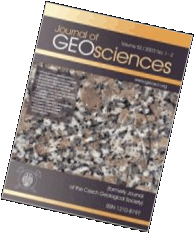 Export to Mendeley
Export to MendeleyOriginal paper
Mineralogy and genetic aspects of the metamorphosed manganese mineralization at the Július ore occurrence near Betliar (Gemeric Unit, Western Carpathians, Slovakia)
Journal of Geosciences, volume 68 (2023), issue 4, 313 - 332
DOI: http://doi.org/10.3190/jgeosci.384
The Július metamorphosed manganese occurrence is situated near the Betliar village in the Spišsko-gemerské rudohorie Mts. (Western Carpathians). Mineralization occurs in the form of manganese carbonate-silicate lenticular body hosted in Lower Paleozoic metasedimentary and metavolcanoclastic rocks of the Bystrý potok Formation, Gelnica Group, Gemeric Unit. The Mn mineralization dominantly consists of rhodochrosite, pyroxmangite, spessartine, magnetite, clino-suenoite, clino-ferro-suenoite, tephroite, pyrophanite and pyrosmalite-(Mn) alongside with pyrite, pyrrhotite, galena, sphalerite, cobaltite, gersdorffite, siegenite, violarite and minor pentlandite and millerite. Very rare minerals, such as hejtmanite, bafertisite as well as a two recently approved members of the epidote supergroup (ferriandrosite-(Ce) and vielleaureite-(Ce)) were also identified. Significant feature of studied mineralization in comparison with the other occurrences of metamorphosed manganese mineralization in the Spišsko-gemerské rudohorie Mts. is the absence of rhodonite. Mineralization at the Július occurrence originates from heterogenous sediment with occurrence of manganiferous, calcareous, argillaceous and terrigenous material with quartz and Ba-rich minerals locally incorporated by material from a volcanic source. Based on mineralogy and ore textures, two metamorphic stages affecting the final mineral composition of Mn mineralization can be distinguished. Generally, the mineral assemblage was likely formed during the Variscan metamorphic stage in the p-T conditions approximately 420-450 °C and pressure 2-4 kbar, as a peak of a metamorphism can be considered the high-grade greenschist facies conditions. Alpine metamorphic phase determined the appearance of veins and veinlets composed of rhodochrosite-chamosite-quartz, pyroxmangite and spessartine. In agreement with lowering temperature of metamorphism and with higher mobility of REE, minerals such as epidotes, baryte and pyrosmalite-(Mn) were formed. Hydrothermal activity led to the formation of sulphides with slightly increased content of Mn. Final stage of metamorphic evolution was influenced by local metasomatic processes.
Webdesign inspired by aTeo. Hosted at the server of the Institute of Petrology and Structural Geology, Charles University, Prague.
ISSN: 1803-1943 (online), 1802-6222 (print)
email: jgeosci(at)jgeosci.org


IF (WoS, 2024): 1.3
5 YEAR IF (WoS, 2024): 1.4
Policy: Open Access
ISSN: 1802-6222
E-ISSN: 1803-1943